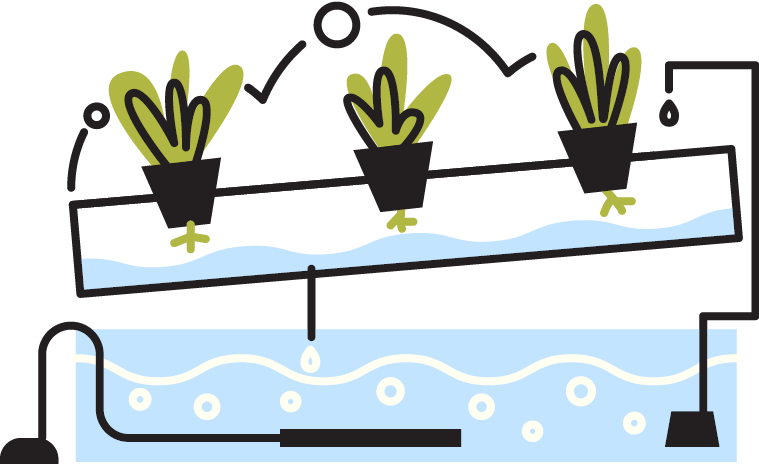
Substrate supply and cost continue to be volatile, causing uncertainty among growers that use traditional, soil-based horticulture methods. The lack of availability and financial pressure could be enough to make growers seek an off-ramp into soilless hydroponic growing methods. But for those who’ve never grown without the constant familiarity of peat-based substrate, the question is how to dive into hydroponics systems in a way that makes sense.
Commercial-style hydroponics can be used in virtually any growing structure, from relatively inexpensive high tunnels to fully automated multi-acre greenhouses. According to Purdue University CEA extension specialist Krishna Nemali, there are some crucial considerations to ensure a hydroponics system provides the best yields for the least cost and effort.
Water awareness
The main consideration for any hydroponics project is access to an adequate amount of good water. Of course, “good” water is a relative term. Nemali notes that water pH is one of the more important factors.
“It needs to be in a manageable range,” Nemali says. “For crops like lettuce, the recommendation is a pH of 6.2 to 6.5.”
To determine water quality, prospective hydroponics growers should procure a full analysis of their water. A pH test is crucial to determine to what extent the water will need to be managed, but equally crucial are tests for pathogens — both plant and human — to ensure consumer safety and disease-free crops.
Space concerns
The production system a grower chooses is somewhat dependent on the amount of space they have available. Production with hydroponic systems also requires certain infrastructure considerations. These might include the type and weight of supplemental lighting in the greenhouse, cooler space for leafy greens and storage for liquid media amendments.
There are additional considerations outside the greenhouse. These include space for shipping and parking, as well as a reclamation pond to catch and collect runoff water used in the operation for treatment and recycling.
Finally, the hydroponics system will need to fit the space. “If you don’t have much space, say 200 to 300 square feet, try vertical production,” Nemali says. “But if you have space, the best way to grow is horizontally because plant quality is going to be good. They will get enough light and grow straight.”
Picking a system
There are several systems under the umbrella of hydroponics. They differ in terms of the way water is used and how the plants are oriented. Most growers will choose among flood and drain tables, nutrient film technique (NFT) and deep water culture. It’s important to note that flood and drain tables still require media that water passes through cyclically.
NFT and deep water culture systems keep roots in contact with water without media.
NFT: A liquid nutrient solution passes through channels, creating a thin film that flows around plant roots. Gravity pulls the liquid from high point to low point along the NFT set-up. After passing over the roots, the liquid media is collected in a small containment area and pumped back to the high point to be reused.
Deep water culture: Plants are arranged on a platform that allows roots access to a reservoir of nutrient solution. The plant roots are bathed continuously by the solution, which is oxygenated through an aeration, or bubble, system.
Most hydroponics companies will offer complete systems, including pH monitoring and pumps, so there is no need to build from scratch. They will also attach to automated fertigation systems.
In deep water culture systems, water temperature remains stable once it’s heated to optimal levels. However, oxygenation is crucial, and bubblers are required. There is also more water to manage.
NFT systems do not require oxygenation. But they are more expensive and require both pumping and heat management to keep solutions at a consistent temperature.
What to grow
“You can grow anything, in theory, that is about 1 to 1 1/2 feet tall,” Nemali says. Traditional hydroponic crops are leafy greens and herbs, but medicinal and edible plants and small cut flowers can be considered. Growers need to keep in mind what their local market will support and consider what crop will be most advantageous.
Nemali offers one final piece of advice. “If you have a decent market and a passion to grow, don’t quit. It’s very rare that people make money in the first two years. But hang in there. We all need food.”
 | The Garden Center Conference & Expo, presented by Garden Center magazine, is the leading event where garden retailers come together to learn from each other, get inspired and move the industry forward. Be sure to register by April 17 to get the lowest rates for the 2025 show in Kansas City, Missouri, Aug. 5-7.
|

Explore the August 2024 Issue
Check out more from this issue and find your next story to read.
Latest from Produce Grower
- PG CEA HERB Part 2: Analyzing basil nutrient disorders
- University of Evansville launches 'We Grow Aces!' to tackle food insecurity with anu, eko Solutions
- LettUs Grow, KG Systems partner on Advanced Aeroponics technology
- Find out what's in FMI's Power of Produce 2025 report
- The Growth Industry Episode 3: Across the Pond with Neville Stein
- The Growth Industry Episode 2: Emily Showalter on how Willoway Nurseries transformed its business
- 80 Acres Farms expands to Georgia, Texas and Colorado
- How BrightFarms quadrupled capacity in six months







